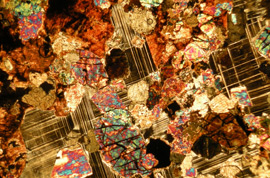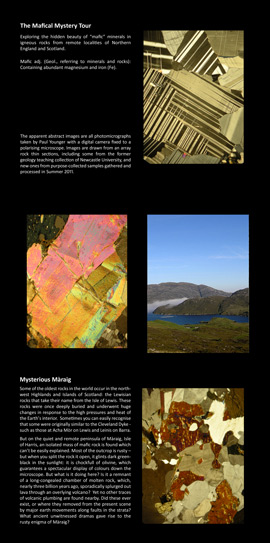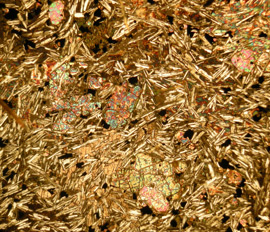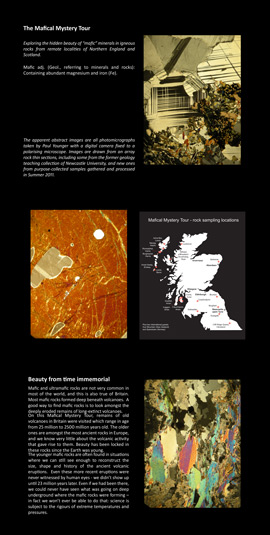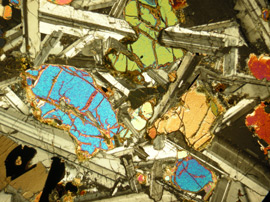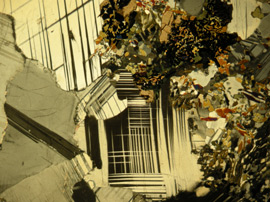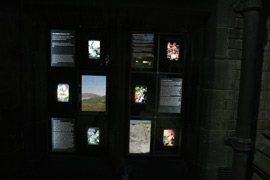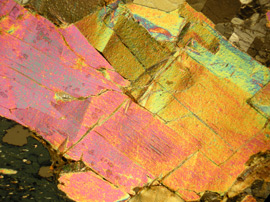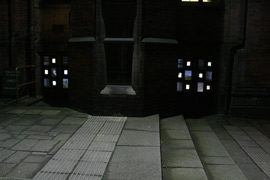Project 15 GOW
November 1st– 2nd December 2011
Professor. Paul Younger
The Mafical Mystery Tour
Recipe:
- Hunt the country for some of the darkest, hardest, rocks you can find; when you’ve found some likely ones get your bricklayer’s hammer out and take bash off some samples.
- Once you’re back home, use a diamond saw (the same thing tile-fitters use) to cut off thin slices of each rock.
- Polish up one face of each rock slice and glue each of them onto its own glass microscope slide.
- Now patiently polish down the other side of each slice until the remaining rock is thin enough to let light through. Keep checking it until it reaches a final thickness of about 30 microns (= 0.03mm).
- Using a microscope fitted with two sets of polarising filters (one above and one below the turntable, set at right-angles to each other), examine the rock and choose minerals to photograph.
The resulting images are the basis of this “mystery tour”, which sampled so-called “mafic rocks” from points between the Outer Hebrides and the Cleveland Hills. “Mafic” is an acronym for “Magnesium and Ferrous rich”, and these rocks typically form in the deep-seated magma chambers far below active volcanoes. In some cases, the volcanic activity caused underground cracking of the Earth for hundreds of miles around, and the molten rock filled these cracks. Thus the rocks sampled in the Cleveland Hills originated beneath an ancient volcano on the Isle of Mull, some 250 miles away in the Inner Hebrides.
The samples collected on this field tour all solidified at least 25 million years ago, and some of them as long as 2500 million years ago; yet in most cases the minerals they contain still look as good as new: that means they’ve not been accessed by enough water to change them into clay minerals, which would otherwise happen quite quickly.
For geologists who study these “thin sections”, they really help to unravel some fundamental mysteries, concerning the otherwise-unobservable processes that occur deep below active volcanoes. There isn’t (and never will be) a way to observe these processes directly, but when we look at these mafic rocks down the microscope, we can reconstruct what must have gone on from the shapes and compositions of the minerals (which correlate with their colours and other features).
For all we can explain how these striking images arise, we can’t “explain them away”. It’s a common error amongst contemporary adherents of “scientism” (you know, the “Science is the answer to everything” brigade; i.e. Dawkins and his ilk) to assume that just because we can explain how something arises we’ve removed all mystery from it. Wrong. We know “how” but not “why”. Why are the fundamental building blocks of matter organised just so that, when we follow the elaborate recipe outlined above, we can suddenly glimpse an otherwise unobservable world? A world impossibly remote from us humans in time, and impossible for us ever to observe directly, given our bodies’ narrow requirements of temperature and pressure.
And for all I’ve been using these thin sections for research and learning purposes for 30 years now, they’ve never lost their fundamental attraction to me: their stunning beauty, with geometries and colours you never see in the ordinary world of everyday nature. And yet these are all natural. Apart from preparing the samples according to the recipe, and choosing which particular views to photograph, the beauty of these minerals is utterly natural, without artifice. The bright reds and greens in these images are usually olivine crystals (though pyroxenes, hornblende and muscovite display similar colours in some of the photomicrographs); the striking black and white stripes are always feldspars. The intimate interdigitation of the separate blebs of colour records complex processes of growth of different minerals at different speeds, as the magma cooled down in its new surroundings.
Biography
Professor Paul Younger is Director of the Newcastle Institute for Research on Sustainability. He is a hydrogeologist and environmental engineer by background, who has been enchanted by the world of “igneous petrology” (the sub-discipline of geology to which these images relate) from the first time he looked down a polarising microscope as a geology undergraduate at Newcastle University in October 1981. He now works on harnessing deep geothermal energy to provide a low-carbon form of renewable energy – an endeavour in which the study of rock thin sections has an important role.
Paul Younger
